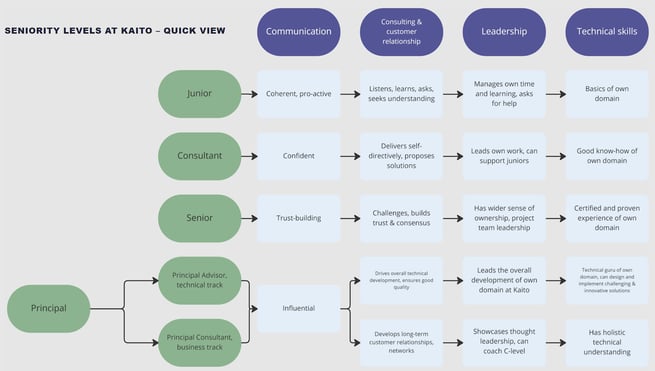In this blog, I will introduce Kaito’s new career path model and explain how it was created. The process is a great example of Kaito's culture and ways of working, as it was started based on feedback from Kaitonians and everyone had a chance to contribute from start to finish.
Need for structure in career development
Kaito is a self-directive organization, and we follow some of the principles of the Sociocracy organization model. In practice, it means that we operate through customer circles and technology guilds, we don't have managers in the traditional sense, information is openly available, and everyone at Kaito shares a great deal of freedom and responsibility.
One of the cornerstones of our company culture is “We support freedom” which reflects our goal of always looking for ways to provide safety and clarity, without limiting freedom. This challenges us to think about the traditional people processes in new ways. One of the recent examples of this is Kaito’s career path and seniority model, which we launched in the beginning of 2023.
Previously, we had no clear career paths or seniority levels at Kaito – we were just a bunch of data and analytics professionals doing what we do best. This worked well for a while, but eventually, we started getting constructive feedback from Kaitonians asking for clear and visible career development opportunities.
We heard the feedback and decided to create a career path and seniority model that would offer structure and clarity, without limiting our people too much, putting them in siloes, or creating unnecessary hierarchy.
Setting up Career Development Paths
The project itself was carried out in a very Kaitonian style; everyone was invited to contribute and share their ideas. We started out by mapping all roles we have at Kaito and creating definitions and titles for the roles. This was done in open workshops with Kaito’s consultants with the help of a role-mapping template I had created.
The project was continued by locking down our seniority levels and their definitions. Deciding on the actual levels was straightforward, but coming up with descriptive but simple descriptions was more complicated and took several iteration rounds.
After the seniority levels and roles had been established, it was time to find each Kaitonian’s place in the seniority map. We took some time to think about how to carry out the process in a way that fits Kaito’s organization and culture. We knew we needed to incorporate the self-directive spirit into the process while ensuring sufficient structure and fairness.
Eventually, we ended up in the following process:
- Consultants asked for feedback from 3-5 stakeholders, including colleagues and customers. Feedback was collected with Kaito’s feedback tool, using a specific, simple questionnaire designed for this purpose.
- Everyone filled out a self-evaluation.
- Everyone was invited to a career development discussion, where we talked about the feedback, self-evaluation and career development and agreed on a seniority level proposal together. Discussions were held by Kaito’s CEO, People & Culture Lead and one of our partners. We wanted the discussions to be coaching- and self-reflection oriented rather than typical performance appraisals.
- Seniority level proposals were reviewed together by Kaito’s partners to ensure they were fair and aligned.
Defining Seniority levels to support career development
In the pictures below, you can see our seniority levels and how they are summarized now.

From now on, we are arranging feedback rounds and career coaching discussions once per year and additionally, it is possible to arrange off-cycle feedback rounds whenever needed. For example, new Kaitonians get to go through their first feedback rounds after six months in the company.
We are not strictly defining people’s roles at Kaito, as they are often not fixed. We are all different and we all have our own career goals, so enabling flexible movement is important to us. Therefore, you can choose to focus on deepening your skills in a narrower area or widening your expertise to new domains.
I wanted to write about the results and behind-the-scenes part of our career path project, as similar blogs and case stories were an important source of inspiration for me when I was doing research for the project.
If you’re interested in themes like organizational culture, self-directiveness, and people processes in a self-directive organization, I’m always happy to network on LinkedIn and exchange ideas! Also, if you’d like to learn more about our career opportunities, I’m happy to have a chat.
Regards,
Aino Ilkka
People and Culture Lead
LinkedIn





